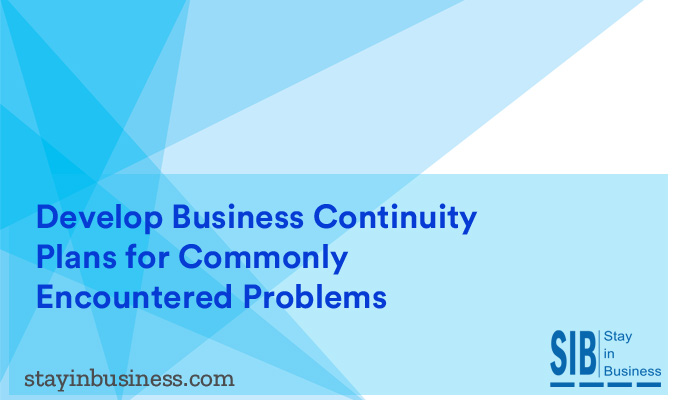
Deploying a business continuity capability takes time. Emergency teams often encounter a lot of resistance when trying to make operations more resilient. Stay in business is a comprehensive business continuity management solution that can deftly tackle these challenges. Below are some common business continuity problems for which you can develop business continuity plans:
Backing from Management and Leadership Teams
Evaluating the cost-benefit ratio of a business continuity solution has its fair share of problems. Management and leadership teams are more concerned with achieving the organization’s commercial goals. One can never accurately forecast the monetary benefits of developing a business continuity capability until a disaster occurs. Besides, the advantages of a business continuity plan are not restricted to a single department, division or operational segment. So, it is difficult to quantify how the organization stands to gain from it.
Stay in Business helps you address this obstacle by developing a detailed vulnerability assessment for the organization’s business model that is supported by tangible financial numbers. Industry specific reports on threats and vulnerabilities that are available in the market can also be taken into consideration while making the pitch to leadership teams for approving a business continuity solution.
Expenditure
Enterprises are constantly cutting costs to make their business more profitable. In such a scenario, investing in a business continuity solution often takes a back seat. Emergency teams can compare the monetary value of the company’s mission critical tasks with the cost of investing in a business continuity solution.
Stay in Business lets you deploy business continuity plans that are prioritized for mission critical operations. These plans can also be completed within specific time frames. The software is ideally suited for creating effective business continuity plans that have a modular structure with minimal interdependencies.
Being Prepared for a Disaster
Many accidents are caused due to human error, negligence and lack of preparation.
With Stay in Business, you can now stay prepared and respond immediately when a disaster occurs, thereby ensuring that your business continues operating despite disruptive incidents.
Insufficient Training
Business continuity teams are often constrained by the lack of skilled staff who can effectively execute plans. Individuals should be able to map their specific tasks at the micro level with the business continuity solution’s overall objective at the macro level.
Stay in Business’ features can be optimized to efficiently schedule periodic training programs that provide company personnel with the necessary knowledge towards this end. Our panel of specialized experts with years of experience in the field can help you develop business continuity solutions that cater to your specific needs.
Attrition
Organizations can give preference to candidates with business continuity competencies when hiring new staff. This way, gaps in skills can be bridged and a smooth transition can be ensured when employees leave the company. Business continuity teams can also save on time needed to train new staff as they have already worked on the domain. The relevant experience of new staff can be used to further enhance the existing business continuity solution.
Consistency
Stay in Business allows you to streamline your organization’s business continuity solution through standard operating procedures. A high level of consistency can be achieved in operations such as taking backups, adapting work environments during incidents, switching to alternate providers, making logistical changes in supply chains and so on.
Coordinating Different Tasks
With Stay in Business, your organization can coordinate tasks that involve different teams in an efficient manner. Plans can be maintained through automated contact verification tools. Sync intervals can be set up in the software that automatically checks for updates from the active directory server.
Segregating Operations Based on Criticality
Stay in business allows you to carefully sort all your business operations based on criticality. Now you can identify your organization’s bare minimum requirements for continuing operations during a disaster and build your resiliency capabilities accordingly. You can elaborate on effective alternatives when there is an impact on one or more of the following resources:
Facilities
Infrastructure
Systems and applications
Personnel
Threats and Vulnerabilities
The SIB application lets you outline all the threats and vulnerabilities that can cause an impact to your business. These hazards occur due to internal as well as external factors such as:
Local Weather Conditions
Insufficient Security Measures
Operational inefficiencies
Defects in Structural Designs
Problems related to management and maintenance
The hazards can be further analyzed based on probability of occurrence and historical data. This information can then be compared with existing business continuity capabilities and mitigation measures.
Alternate Options for External Vendors
Outsourcing is a big part of any business today. Disruption to any of these crucial supplies can be disastrous for the organization’s deliverables. While vendor risks are beyond your organization’s control, Stay in Business still lets you stay prepared by planning backup options for supplies related to:
Mission Critical Business Products
Utilities such as power, gas, water and so on
Internet Connectivity
Waste and Residue Management
See for yourself how the application works
Witness our cloud based platform’s security capabilities in action
Play around with the software and explore its features
Compare and choose a solution that’s relevant to your organization
Consult our experts and decide on a pricing mechanism
Disasters
[carousel id=’1780′ items=’4′ items_desktop=’3′ margin_right=’5′ navigation=’false’] [item img_link=”https://www.stayinbusiness.com/wp-content/uploads/2016/02/Chemical-Spills-Discharges.jpg” href=”https://www.stayinbusiness.com/resource/disaster-recovery/chemical-spills-and-discharges/”][item img_link=”https://www.stayinbusiness.com/wp-content/uploads/2016/02/Riots-Public-Disturbances.jpg” href=”https://www.stayinbusiness.com/resource/disaster-recovery/riots-and-public-disturbances/”][item img_link=”https://www.stayinbusiness.com/wp-content/uploads/2016/02/Terrorism.jpg” href=”https://www.stayinbusiness.com/resource/disaster-recovery/terrorism/”] [item img_link=”https://www.stayinbusiness.com/wp-content/uploads/2016/02/worst-product-recall.jpg” href=”https://www.stayinbusiness.com/resource/disaster-recovery/product-recall/”] [/carousel]
